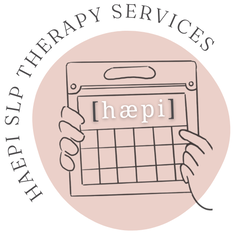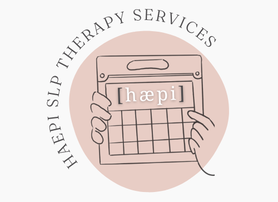|
As SLPs, we have the opportunity to embed social-emotional learning into traditional language therapy, and a holistic approach to speech-language pathology would encourage us to take it!
An easy way we can do this is by building on the concepts that we are already teaching. For instance, we often target "wh questions" (e.g., who, what, when, where, why), but we don't always take the step further to delve into how we can *feel* these concepts in our bodies, and how we can express them with our emotions. Example: In this reel, I'm working on 'when' questions with a group virtual session. Notice how I'm using the SLP topic to talk about social-emotional learning and identifying emotions. This is not an activity in identifying good vs. bad emotions, but simply highlighting different strategies that we can use when we feel certain things. by Halle Demchuk, SLPPaediatric SLP | GLP-Trained Clinician | Owner of HAEPI SLP This is going to be a vulnerable post, because part of reducing stigmatization involves being vocal and encouraging healthy discussion! I've struggled with anxiety and intrusive thoughts my whole life. While the earliest memories that I have are from age 7, my mom remembers my symptoms appearing as early as age 2. I had periods of time that were "easy" and periods of time that were… really hard. I didn't understand that this was obsessive compulsive disorder (OCD) until I was 23, and it was even later that I identified as neurodivergent. The larger neurodiversity movement helped me identify my own neurodivergence (i.e., being on the obsessive compulsive spectrum), and this has brought me more inner peace than I can articulate (but if I were to try, I'd say I finally started to feel seen, validated, affirmed, reassured, and understood). I never thought I could (or would!) share this information with the public. Over the years, I've felt a lot of shame and masked a lot of my feelings and symptoms because I wanted to appear "normal." At other times, I felt like I wasn’t neurodivergent *enough* to seek the supports/information that would help me thrive. But understanding that my brain is just wired differently, that my caudate nucleus (along with other areas in my orbital cortex) is hyperactive — and that other people experience the same thing!?! — has been life-changing. I now view my OCD as information (about me and about my brain) and it is something (neutral, neither good nor bad) that I simply have to manage as I move through life. Since it is a part of me, though, it also contributes to who I am as a clinician. I feel like I can better relate to my clients who have anxiety and sensory preferences. My attention to detail is a strength. I can use my own neurodiversity to help my clients feel empowered by theirs. I can demonstrate how to focus on one's strengths, and to give grace to areas that may need more support. Most importantly, I can create a therapeutic environment that will prevent the internalization of shame. Because there is nothing shameful about it. by Halle Demchuk, SLPPaediatric SLP | GLP-Trained Clinician | Owner of HAEPI SLP
In my experience, the BIGGEST predictor of AAC success is if the child experiences JOY from communicating with the device.
Too often, AAC is treated like "work" for the learner, and they are expected to use it in a certain way (e.g., they have to say how they feel or what their name is). We know that is approach of adding expectations doesn't work for late-talkers (and why it is common practice in the SLP world to discourage parents from insisting that their child "say X" and "say Y"). The exact same approach is needed with our AAC learners. We need to create situations that are intrinsically motivating for our learners, and show them that communication does lead to shared joy! For a learner like this, I have modelled bubbles many times, and if she is struggling to find it, I would not insist that she needs to. I'd show her where it is again, and continue to model other words. However, she is showing us all her intent and ability to communicate about something that brings her so much joy. Video shared with consent. by Halle Demchuk, SLPPaediatric SLP | GLP-Trained Clinician | Owner of HAEPI SLP
Requesting is a very common strategy and goal used in speech therapy, but there's a lot more to language than just that!
I believe that kids of all abilities should be exposed to and taught how to use all sorts of different functions of communication, from telling stories and answering questions to saying no and arguing! This of course includes AAC users. Having access to colourful language simply means that a variety of kinds of language should be modelled for them throughout the day. Requests are often focused on because they result in a reward, however, communication is its own reward, and it's our job to show them that. by Halle Demchuk, SLPPaediatric SLP | GLP-Trained Clinician | Owner of HAEPI SLP
Although I focus a lot of my content on AAC and GLP, I also LOVE working with children with speech sound difficulties, including articulation difficulties.
Since taking the Play-based Speech Therapy Course by @anna.dee.slp and @wordsmatterslp, my articulation sessions have become mostly play-based and I have noticed increased engagement and motivation, which has led to increased success (don't you learn better too when you're enjoying it?!). I also learned that articulation therapy can be *more* successful by including fewer targets, including multiple target sounds in one activity, and using targets and activities that have more carry-over to the child's everyday life. Not to mention how movement can help regulate kids while learning! (Mini items are from @speechtreeco, which I may have a slight obessession with...) by Halle Demchuk, SLPPaediatric SLP | GLP-Trained Clinician | Owner of HAEPI SLP |
The HAEPI BlogCheck here for HAEPI updates, helpful SLP information, free resources, articles, and more!
Archives
June 2024
Categories
All
|
Empowering Happy Communicators |
get in touch |
Quick Links |
© HAEPI SLP THERAPY SERVICES.
HAEPI SLP Therapy Services is proudly neurodiverse, Indigenous-owned, and woman-operated.



